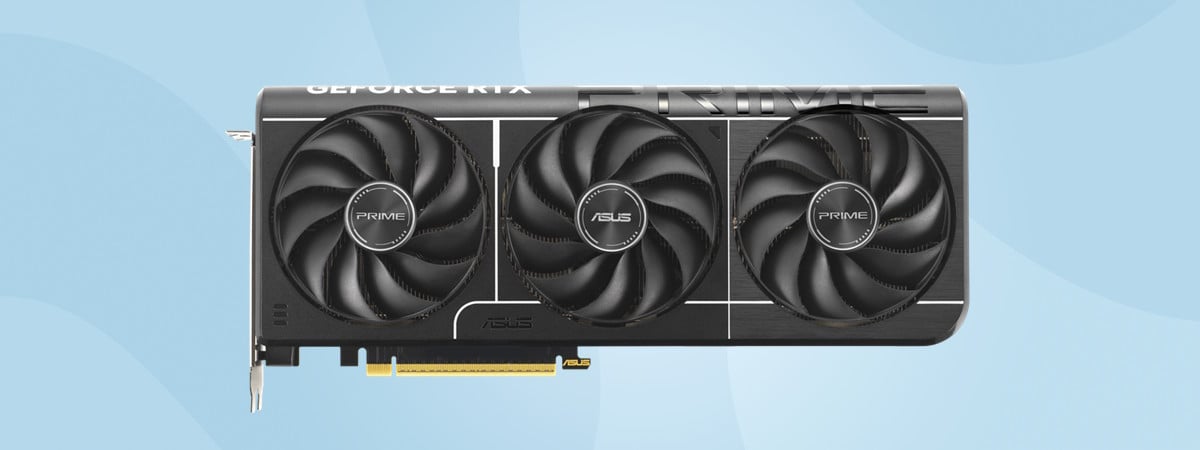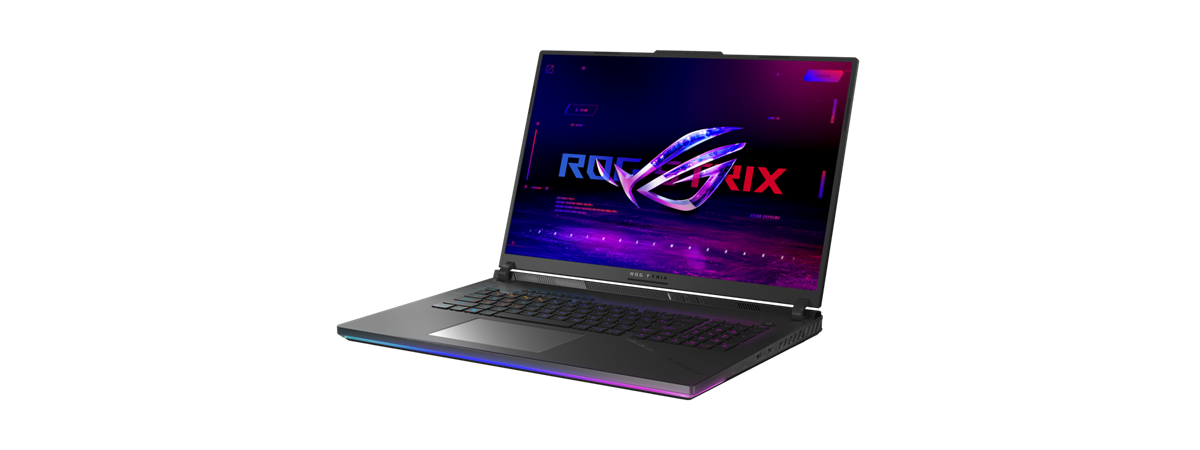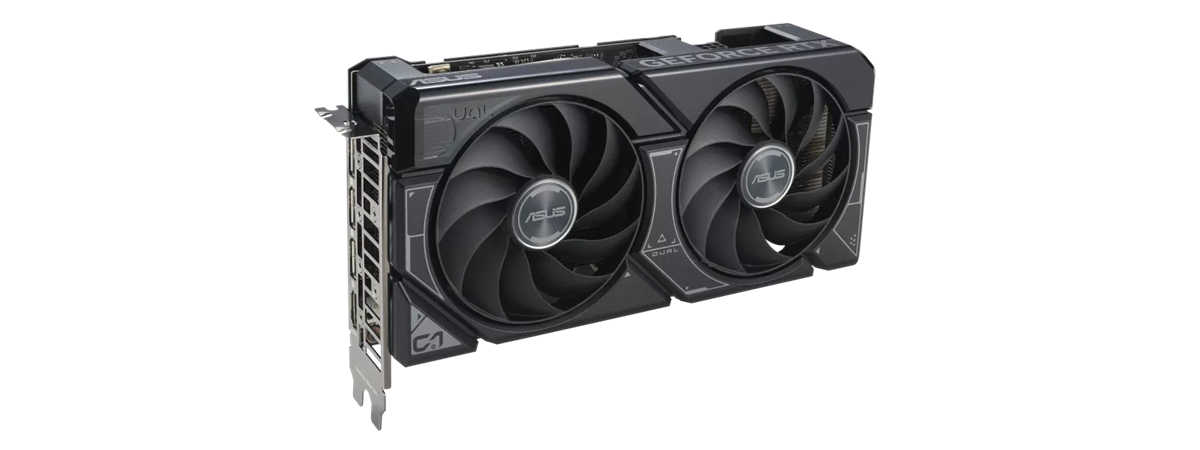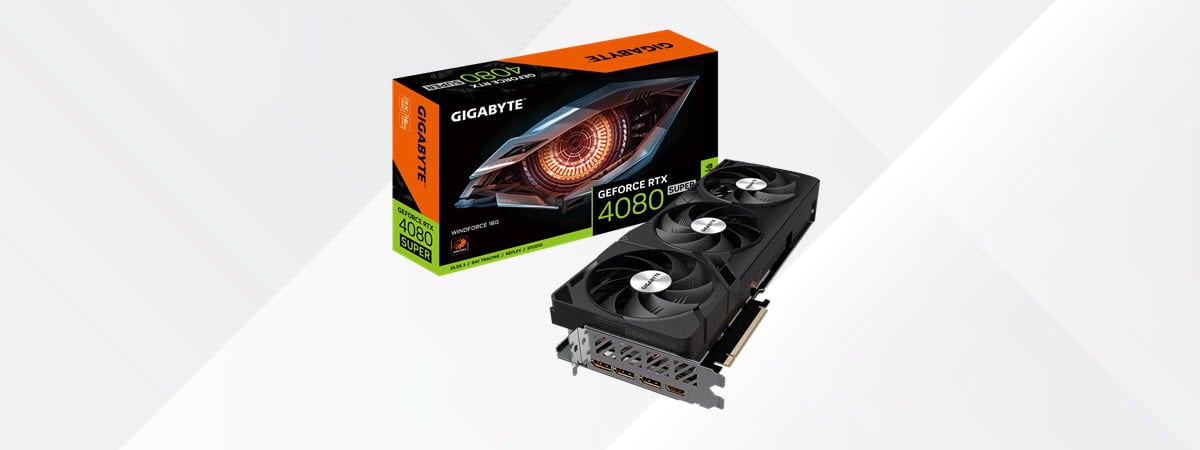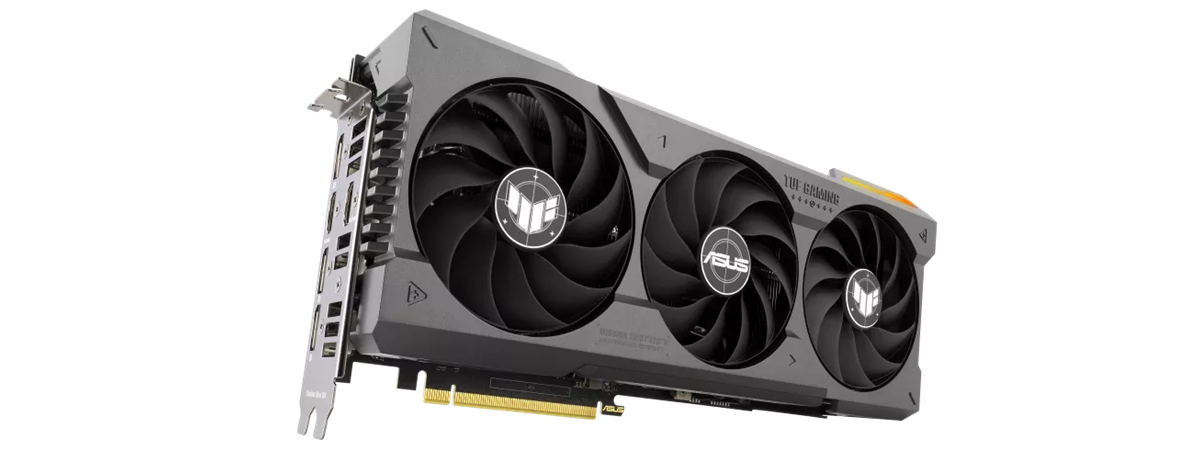
The latest family of NVIDIA graphics cards, the RTX 4000 series, includes so far three GPUs: the RTX 4090, RTX 4080, and the RTX 4070 Ti. There will be an RTX 4060 too, but we don’t have any official information about it when writing this review. Today, RTX 4070 Ti is the most affordable option, but that doesn’t mean it’s weak by any means. In fact, it should offer performance levels similar to or even better than what we got from the previous generation RTX 3090. To put this assumption to the test, I’m reviewing the newly launched ASUS TUF Gaming GeForce RTX 4070 Ti 12GB GDDR6X OC Edition. If you want to see what it offers and how good the gaming experience you get from it is, read this review:
ASUS TUF Gaming GeForce RTX 4070 Ti OC Edition: Who is it good for?
This graphics card is an excellent choice if you want:
- Gaming at Ultra settings and high framerates in 1440p resolution
- Good ray tracing performance and DLSS 3
- A powerful GPU with a reasonable power consumption
Pros and cons
Here is what I like about the ASUS TUF Gaming GeForce RTX 4070 Ti 12GB GDDR6X OC Edition:
- Top-notch performance in 1440p resolution and good performance in 4K
- Ray tracing performance is better than the previous generation
- Support for the DLSS 3 upscaling technology
- Plenty of fast GDDR6X video RAM (12 GB)
- Excellent cooling system and overclocked mode
- Power consumption is relatively low (less than 300 Watts)
On the negative side, this graphics card and Nvidia GeForce RTX 4070 Ti GPUs in general:
- Have a high price that doesn’t feel well balanced
- Don’t have DisplayPort 2.1, and I can find no reason why NVIDIA chose not to implement it on RTX 4000 GPUs
- Use a 16-pin power connector instead of two standard 8-pin PCIe connectors (which should be enough for the RTX 4070 Ti)

Verdict
The ASUS TUF Gaming GeForce RTX 4070 Ti 12GB GDDR6X OC Edition is an excellent graphics card in terms of performance and efficiency. It can handle any game in 1440p resolutions, at high framerates and Ultra settings. Furthermore, it’s also quite capable of running games in 4K, although, for a high number of fps, you’ll want to enable DLSS and/or decrease the visual quality settings. If you’re an NVIDIA fan and want to upgrade from an RTX 2000 series, the RTX 4070 Ti is worth it. However, if you already have a high-end RTX 3080 Ti or 3090 card, upgrading might not offer an improvement as big as you’d expect. With all that being said, I still I believe that the ASUS TUF Gaming GeForce RTX 4070 Ti 12GB GDDR6X OC Edition deserves our top verdict of 5 stars and the Buy for Gamers badge.
Design and hardware specifications
Built on the Ada Lovelace architecture, the RTX 4070 Ti is designed to deliver high framerates in most games though not in 4K resolutions, but rather in 1440p. As we’ll find later in the benchmarks section of this review, the card can run some less demanding games in 4K at over 100 frames per second. However, where it really shines is 1440p.
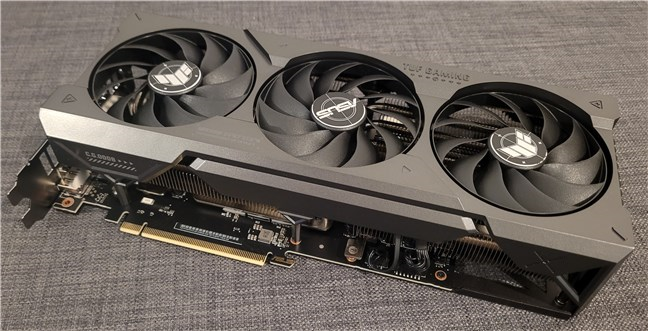
The ASUS TUF Gaming GeForce RTX 4070 Ti 12GB GDDR6X OC Edition
Working on the PCI Express version 4.0, the ASUS TUF Gaming GeForce RTX 4070 Ti 12GB GDDR6X OC Edition graphics card features 7680 CUDA cores and 12 GB of GDDR6X RAM on a 192-bit memory bus width (21 Gbps memory speed). The card’s engine (boost) clock ticks at a frequency of 2730 MHz in default mode and can reach 2760 MHz in OC (overclocked) mode.
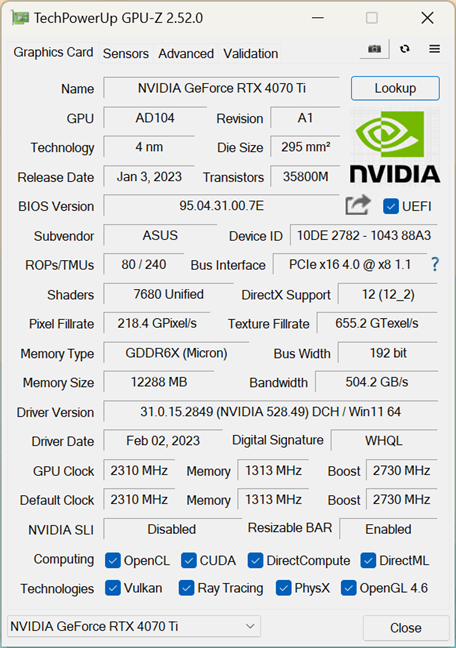
Tech specs of the ASUS TUF Gaming GeForce RTX 4070 Ti 12GB GDDR6X OC Edition
To turn ASUS’ OC Mode on or off, you can use the small switch found on the card’s edge. The OC Mode on is named Performance Mode, while the OC Mode off is signaled by the Quiet Mode text.
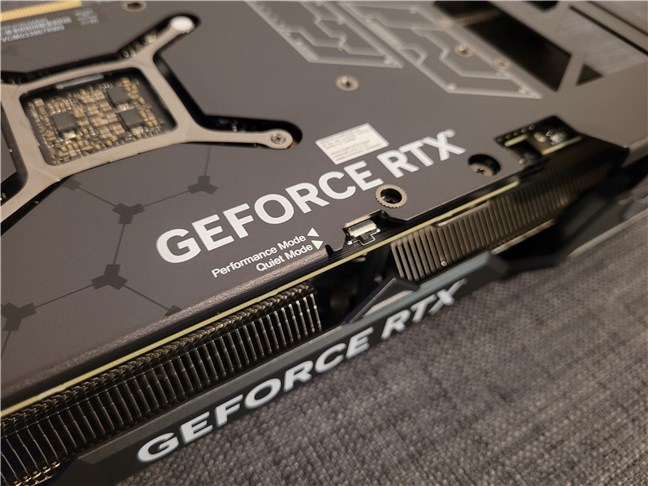
This ASUS RTX 4070 Ti GPU is overclocked out of the factory
Like the RTX 4080 and RTX 4090 GPUs, the RTX 4070 Ti also supports DLSS 3. This is the latest revision of NVIDIA’s DLSS tech (Deep Learning Super Sampling), which offers the possibility of running games with ray tracing effects at higher framerates. That means you can enjoy more realistic lighting effects, shadows, and reflections in your favorite games even if those games are very demanding and the GPU struggles at handling high resolutions such as 4K. Although there is some loss in visual quality, it’s not really visible to the naked eye.
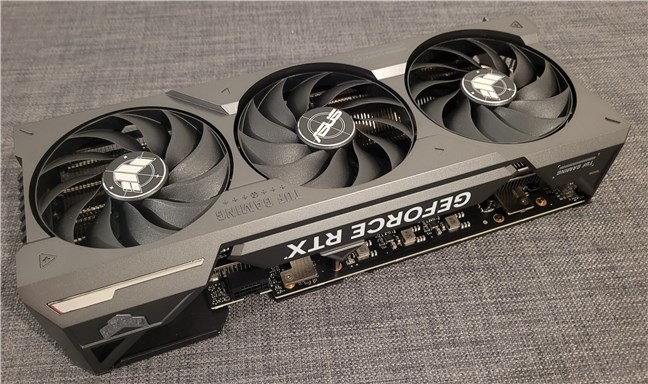
The RTX 4070 Ti GPU supports DLSS 3
ASUS’ TUF Gaming GeForce RTX 4070 Ti 12GB GDDR6X OC Edition graphics card offers five output ports: two HDMI 2.1a ports and three DisplayPort 1.4a ports. In total, you can connect up to four displays simultaneously, at a maximum resolution of 7680 x 4320 pixels.
Unfortunately, none of NVIDIA’s RTX 4000 cards, the 4070 Ti included, offers DisplayPort 2.1. That’s a shame, really.
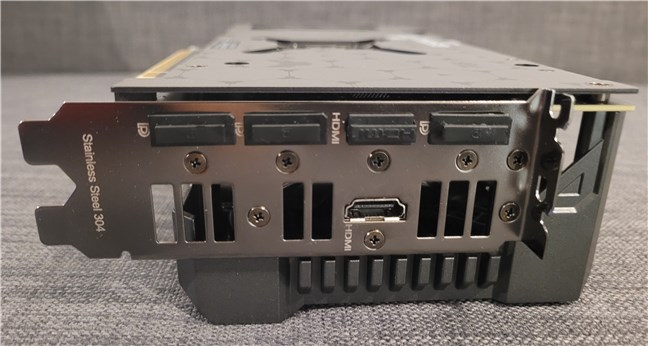
There are five display output ports on the graphics card
Just like we’ve seen on all of the TUF Gaming graphics cards released by ASUS, the GeForce RTX 4070 Ti 12GB GDDR6X OC Edition also features a three-fan cooling solution. The company used axial fans with dual-ball fan bearings, saying that these would provide up to 21% more airflow and last up to twice as much as conventional designs.
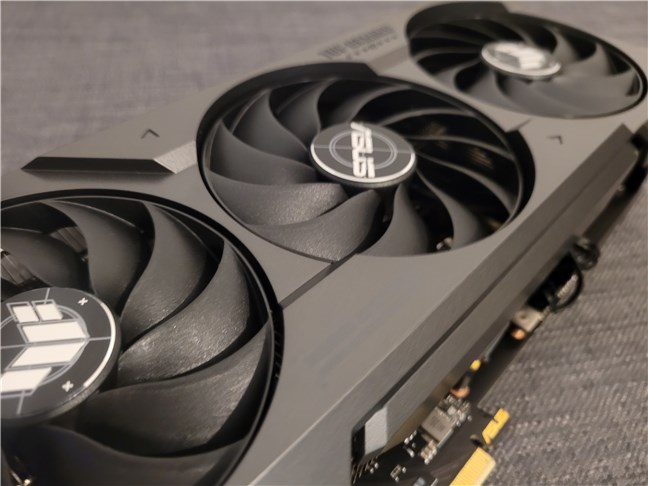
The card uses three axial fans to cool
To further aid with heat dissipation, as well as provide stability and rigidity, the graphics card is covered by a large metallic backplate. Featuring a large beehive hexagonal design and rather discrete imprints of the TUF branding and logo, I must say it looks quite good.
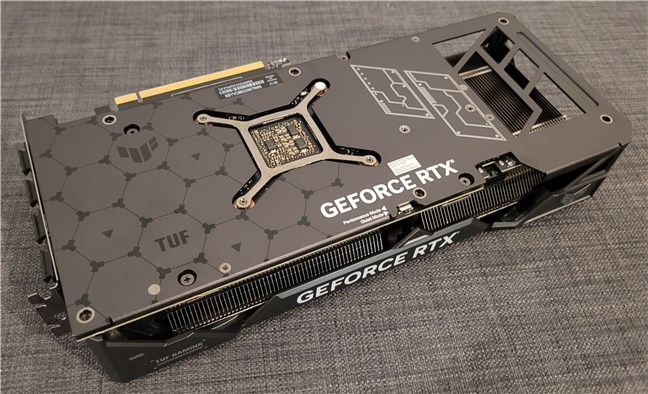
ASUS mounted a large metal backplate on the graphics card
A poor design choice, in my opinion, though not from ASUS but rather from NVIDIA, is the fact that the RTX 4070 Ti requires the use of a 16-pin power cable. Why? As you’ll see in the benchmarks section of this review, the GPU requires less than 300 Watts to run at maximum speed (a 750 Watts power supply is recommended), which means that it could have used two standard PCIe 8-pin power connectors.
I see no reason to add another cable (that combines two 8-pin connectors into a 16-pin connector). It’s really no fun at all to add to the mess in your PC case by having to deal with another cable.
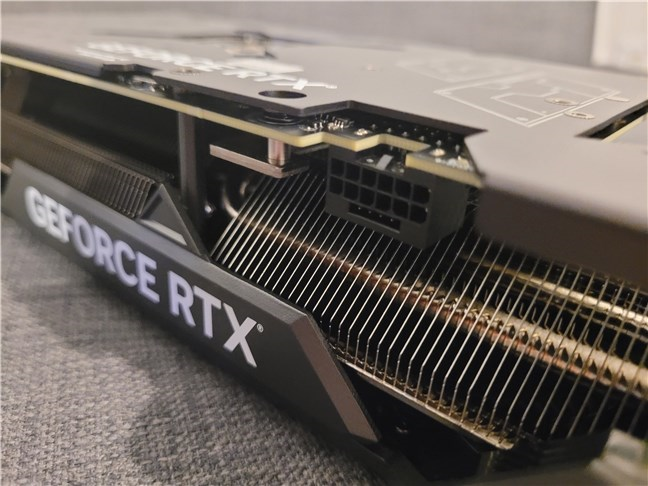
NVIDIA RTX 4070 requires a 16-pin power connector
On another note, a thing you may like about the ASUS TUF Gaming GeForce RTX 4070 Ti 12GB GDDR6X OC Edition is the fact that it also has RGB lighting. The lights are compatible with ASUS’ Aura Sync software, and they’re also rather subtle: a small TUF logo and a line under it, both positioned towards the front end of the graphics card.
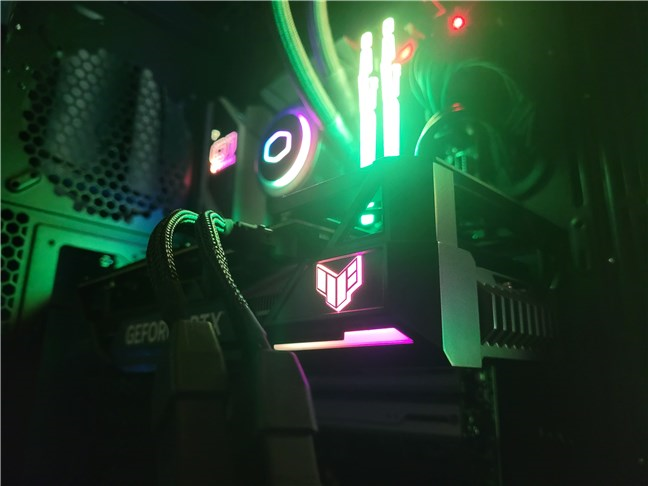
The RGB lights on the ASUS TUF Gaming RTX 4070 Ti graphics card
Regarding size, you should know that the ASUS TUF Gaming GeForce RTX 4070 Ti 12GB GDDR6X OC Edition is a large graphics card. Measuring 30.5 cm (12 inches) in length, 13.8 cm (5.43 inches) in width, and with a thickness of 6.5 cm (2.56 inches), the card effectively occupies four PCIe slots (3.25 to be exact). Keep that in mind if you intend to mount other cards on the PCI Express slots available on your motherboard.
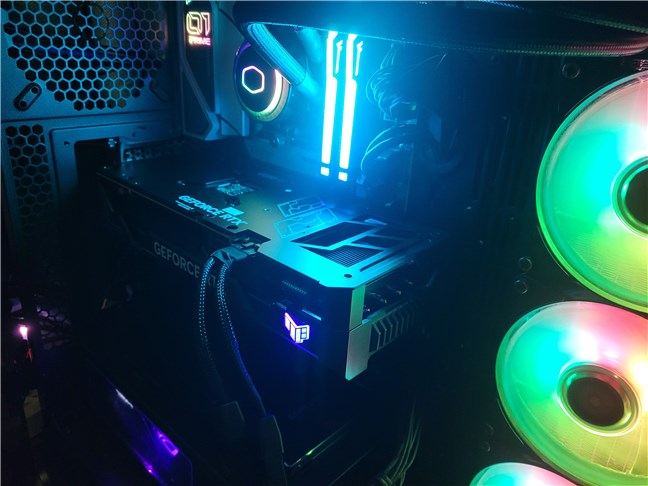
This card is large and very thick
The ASUS TUF Gaming GeForce RTX 4070 Ti 12GB GDDR6X OC Edition features excellent technical specifications and an efficient design. Built on the latest GPU architecture from NVIDIA, it should offer high framerates if you’re gaming in 1440p resolution or lower. It should also be a reasonably viable option for 4K gaming, depending on the game you play, whether or not you’re using DLSS or are OK with either lower framerates or medium visual quality.
If you want more details about this graphics card’s hardware specs and features, visit this webpage: ASUS TUF Gaming GeForce RTX 4070 Ti 12GB GDDR6X OC Edition - Tech Specs.
Performance in games and benchmarks
To see the levels of performance you get from the ASUS TUF Gaming GeForce RTX 4070 Ti 12GB GDDR6X OC Edition graphics card in real life, I ran a series of gaming benchmarks. I also compared its results with the ones of an AMD Radeon RX 7900 XTX and an AMD Radeon RX 7900 XT that I previously tested using the same hardware components:
- Motherboard: ASUS Prime X670E-Pro WiFi
- Processor: AMD Ryzen 9 7900X
- CPU cooler: Cooler Master MasterLiquid ML360R RGB
- Memory: Kingston Fury Beast RGB DDR5-6000 32GB
- Storage: Kingston KC3000 NVMe PCIe 4.0 SSD 2TB
- Monitor: ASUS ROG Strix XG32UQ
- Power Supply Unit: ASUS ROG Thor 850W Platinum
- Operating System: Windows 11 Pro version 22H2
Before we go through the results, I also have to mention the fact that all the games were tested using the highest possible (Ultra) graphics settings and with ray tracing effects turned on (high-quality settings) in the games that support them. I didn’t use DLSS or AMD FSR upscaling technologies, as I wanted to see how the cards compare in raw performance.
I started with CyberPunk 2077, an extremely beautiful game that demands a lot of performance from the graphics card. On the Ray Tracing Ultra preset, the ASUS TUF Gaming GeForce RTX 4070 Ti 12GB GDDR6X OC Edition rendered an average of 77 frames per second in 1080p resolution, 50 fps in 1440p, and 20 fps in 4K. These are, quite frankly, amazing results, showing that NVIDIA continues to outmatch AMD when it comes to ray tracing performance. The RTX 4070 Ti proved significantly faster than both the AMD Radeon RX 7900 XTX (about 22% increase in framerate) and 7900 XT (roughly 38% performance increase) in 1440p and 1080 resolution. However, in 4K, the Radeon RX 7900 XTX was a bit faster than the RTX 4070 Ti.
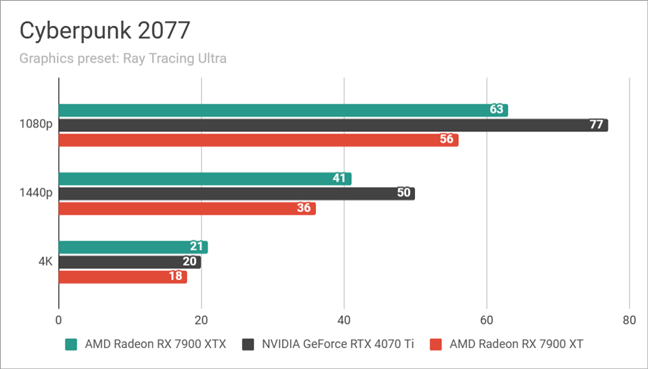
ASUS TUF Gaming GeForce RTX 4070 Ti 12GB GDDR6X OC Edition: Benchmarks results in Cyberpunk 2077
The second game I benchmarked was The Callisto Protocol. This one, too, requires a powerful graphics card to be enjoyed at maxed visual quality. Using the Ultra graphics preset and with ray tracing effects set on high, the ASUS TUF Gaming GeForce RTX 4070 Ti 12GB GDDR6X OC Edition managed to consistently render over 60 frames per second in all three resolutions tested. However, except for 4K, it proved to be slower than both the Radeon RX 7900 XTX (which delivered a 15 to 17% increase in fps) and Radeon RX 7900 XT (fps increase of 7 to 12%). In 4K, the ASUS TUF Gaming GeForce RTX 4070 Ti 12GB GDDR6X OC Edition was slower than the Radeon RX 7900 XTX (which offers a ~19% fps increase) but much faster (63% fps increase) than the AMD Radeon RX 7900 XT.
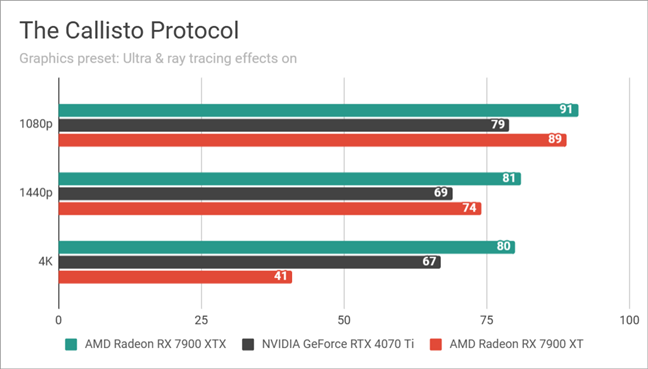
ASUS TUF Gaming GeForce RTX 4070 Ti 12GB GDDR6X OC Edition: Benchmarks results in The Callisto Protocol
The third game I checked was The Witcher 3: Wild Hunt Next-Gen Update. Running fluently using the RT Ultra graphics preset proved to be a major problem for all graphics cards, but the ASUS TUF Gaming GeForce RTX 4070 Ti 12GB GDDR6X OC Edition constantly did better than both AMD Radeon cards tested, even in 4K resolution. Compared to the Radeon RX 7900 XTX, the RTX 4070 Ti offered an fps increase of 4 to 6%, while compared to the Radeon RX 7900 XT, the performance increase was of about 19 to 23%, depending on the resolution.
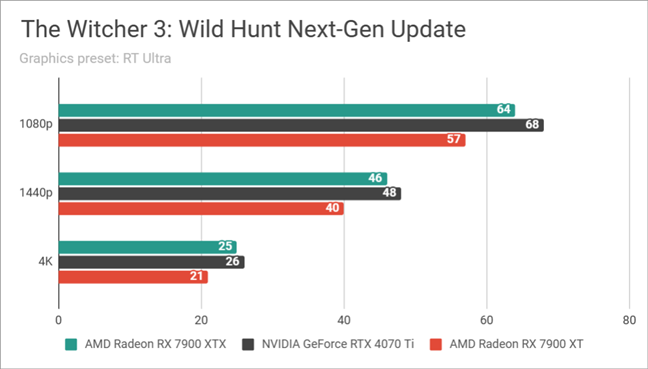
ASUS TUF Gaming GeForce RTX 4070 Ti 12GB GDDR6X OC Edition: Benchmarks results in The Witcher 3 Wild Hunt Next-Gen Update
Next, I tested Total War WARHAMMER III, a game that doesn’t include ray-tracing effects. AMD Radeon cards were better than the ASUS TUF Gaming GeForce RTX 4070 Ti 12GB GDDR6X OC Edition. However, even if the average framerates measured with the RTX 4070 Ti weren’t as high as the ones of the other cards, they were excellent nonetheless. In 1080p and 1440p, the GPU can handle over 100 fps (frames per second) easily, and if you’re OK with 60 fps, it’s close to that in 4K too.
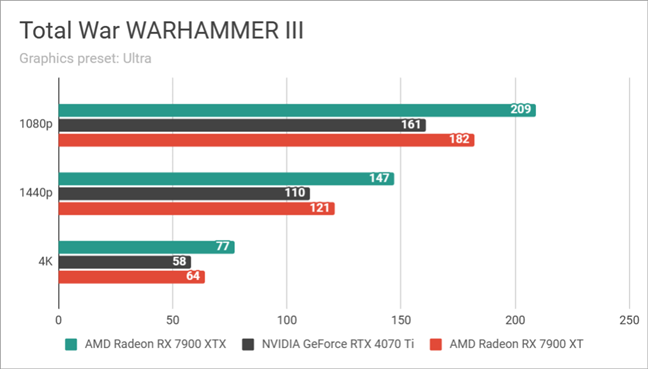
ASUS TUF Gaming GeForce RTX 4070 Ti 12GB GDDR6X OC Edition: Benchmarks results in Total War WARHAMMER III
Ubisoft’s Assassin’s Creed Valhalla doesn’t have ray tracing effects either, but the beautiful visuals in it demand a lot of graphics performance. Similarly to what I’ve seen in Total War WARHAMMER III, the RTX 4070 Ti rendered amazingly high framerates in both 1080p and 1440p resolutions, matching or close to the standard 144 Hz refresh rate used by most gaming monitors today. Even in 4K, the card was able to go over the 60 fps minimum requirement for a good gameplay experience, reaching an average of 81 fps. However, it’s worth noting that the AMD Radeon RX 7900 XTX and the Radeon RX 7900 XT were both faster than the GeForce RTX 4070 Ti (by at least 10%), no matter what resolution I used.
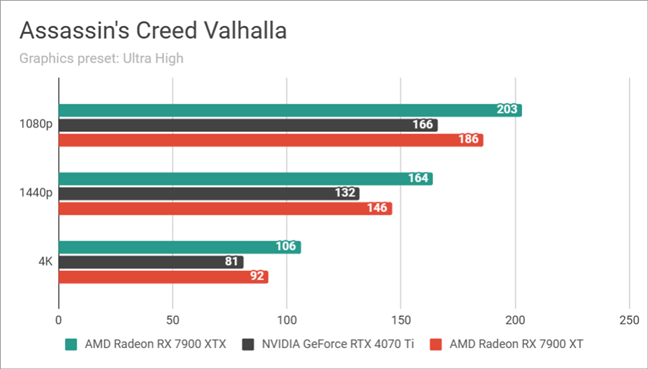
ASUS TUF Gaming GeForce RTX 4070 Ti 12GB GDDR6X OC Edition: Benchmarks results in Assassin's Creed Valhalla
I continued the benchmarks with Resident Evil Village, a slightly older game but one that still impresses with its graphics. Although it has ray tracing effects, the game is not as demanding as others, and that’s immediately clear from the results I got. Regardless of the resolution or the graphics card I used, the framerate was above 100 fps. The ASUS TUF Gaming GeForce RTX 4070 Ti 12GB GDDR6X OC Edition rendered about the same average number of frames per second in 1080p and 1440p (141 and 143 fps), which is exactly what you want if you have a gaming monitor with a standard 144 Hz refresh rate. Furthermore, even in 4K, the card managed to offer 103 fps, which is quite amazing. On the other hand, both the AMD Radeon RX 7900 XTX and the Radeon RX 7900 XT managed even higher outputs, offering a performance increase of anywhere from 5 to 43% more fps, depending on the resolution and GPU model.
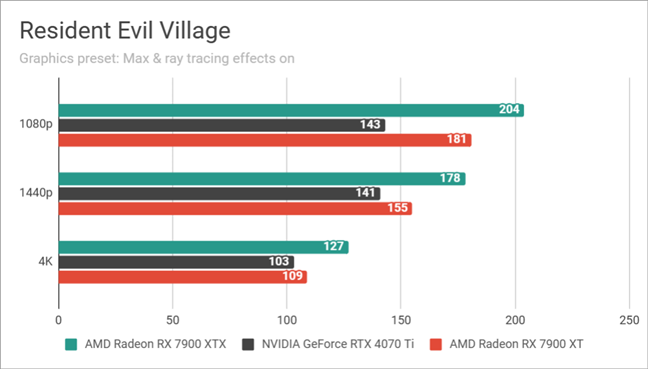
ASUS TUF Gaming GeForce RTX 4070 Ti 12GB GDDR6X OC Edition: Benchmarks results in Resident Evil Village
In the last game I tested, F1 22, the ASUS TUF Gaming GeForce RTX 4070 Ti 12GB GDDR6X OC Edition was slightly faster than the AMD Radeon RX 7900 XT in 1080p and 1440p resolution, but only by a few percent. The Radeon RX 7900 XTX was noticeably faster in all resolutions, while the Radeon RX 7900 XT managed a few frames more than the RTX 4070 Ti in 4K.
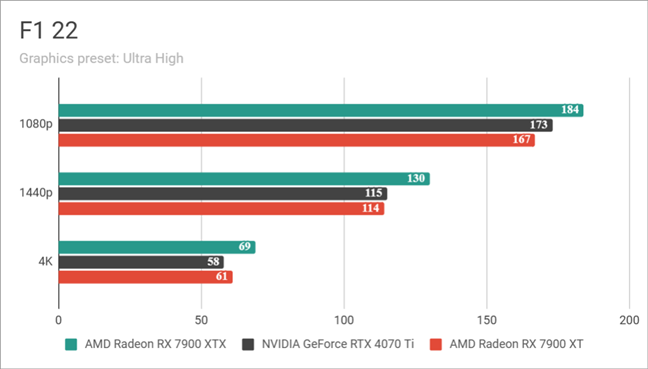
ASUS TUF Gaming GeForce RTX 4070 Ti 12GB GDDR6X OC Edition: Benchmarks results in F1 22
Last but not least, I also ran a few tests from the 3DMark gaming benchmarking app: Time Spy Extreme (evaluates performance in 4K gaming), Port Royale (evaluates ray tracing performance), and Speed Way (evaluates performance in games that use DirectX 12 Ultimate). The NVIDIA GeForce RTX 4070 Ti GPU obtained excellent results in all tests. If you look at the chart below, you can see that the results point out the same conclusion we got from the games benchmarked: the RTX 4070 Ti is better than the AMD Radeon RX 7900 XT and weaker than the AMD Radeon RX 7900 XTX in new games that use DirectX 12 Ultimate or fancy ray tracing effects, while also being slower than both AMD competitors at gaming in 4K.
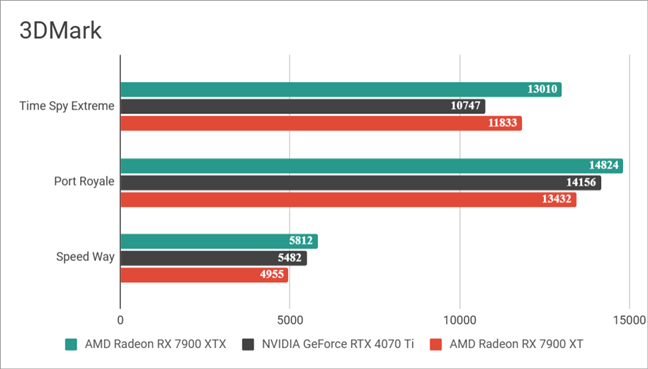
ASUS TUF Gaming GeForce RTX 4070 Ti 12GB GDDR6X OC Edition: Benchmarks results in 3DMark
Temperatures and power consumption are also important when evaluating a hardware component such as a graphics card. The ASUS TUF Gaming GeForce RTX 4070 Ti 12GB GDDR6X OC Edition kept stable at about 75 degrees Celsius (167 Fahrenheit) even when stressed with Furmark, and its power consumption didn’t go higher than 285 Watts. That’s less than either AMD Radeon RX 7900 GPU I compared it with, which is great. However, it also shows that NVIDIA didn’t have to require the 16-pin power connector for the RTX 4070 Ti GPU; two PCIe 8-pin connectors would’ve sufficed.
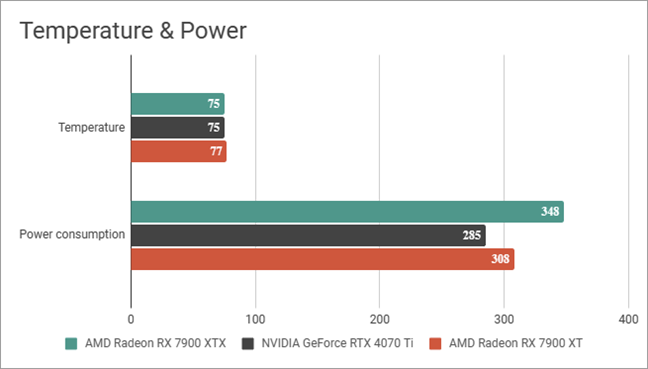
ASUS TUF Gaming GeForce RTX 4070 Ti 12GB GDDR6X OC Edition: Maximum temperature and power consumption
The ASUS TUF Gaming GeForce RTX 4070 Ti 12GB GDDR6X OC Edition proves to be an excellent graphics card that offers a lot of performance, especially in gaming up to 1440p. While also a capable GPU for 4K gaming, in this case, you’ll probably need to use DLSS upscaling or lower the visual quality in more demanding games.
What is your opinion about the ASUS TUF Gaming GeForce RTX 4070 Ti 12GB GDDR6X OC Edition?
Now you know what the ASUS TUF Gaming GeForce RTX 4070 Ti 12GB GDDR6X OC Edition has to offer and what it can do in gaming. Although it’s a pretty powerful GPU we’re talking about, its price might not be to the liking of many, especially considering the competition. What do you think? Do you intend to buy it, or are you looking at alternatives? Let me know your opinion about the ASUS TUF Gaming GeForce RTX 4070 Ti 12GB GDDR6X OC Edition in the comments section.


 24.02.2023
24.02.2023 